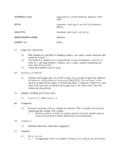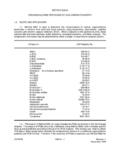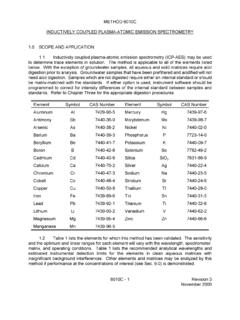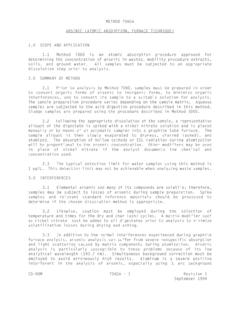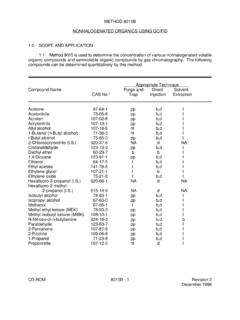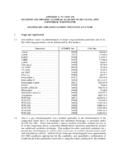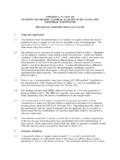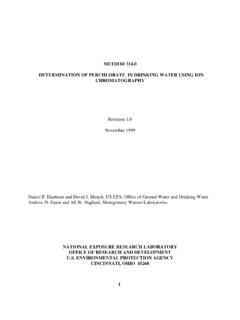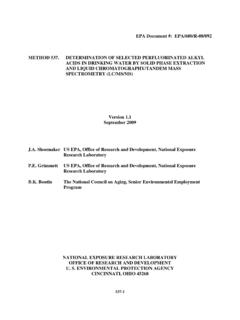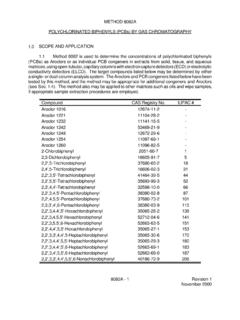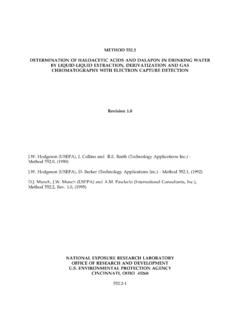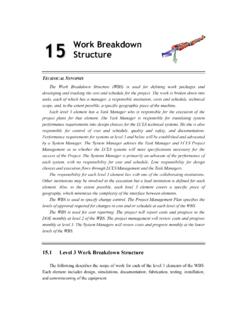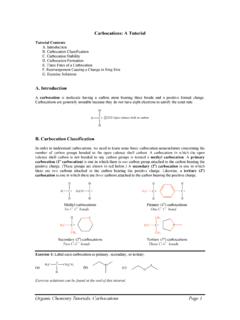Transcription of METHOD 515.1 DETERMINATION OF CHLORINATED …
1 METHOD DETERMINATION OF CHLORINATED ACIDS IN WATER BY GAS. chromatography with AN electron capture DETECTOR. Revision Edited by Munch (1995). Dressman and Lichtenberg - EPA 600/4-81-053, Revision (1981). Hodgeson - METHOD 515, Revision (1986). D. J. Munch (USEPA, Office of Water) and T. Engel (Battelle Columbus Laboratories) - National Pesticide Survey METHOD 3, Revision (1987). Graves - METHOD , Revision (1989). NATIONAL EXPOSURE RESEARCH LABORATORY. OFFICE OF RESEARCH AND DEVELOPMENT. ENVIRONMENTAL PROTECTION AGENCY. CINCINNATI, OHIO 45268. METHOD DETERMINATION OF CHLORINATED ACIDS IN WATER BY GAS. chromatography with AN electron capture DETECTOR. SCOPE AND APPLICATION. This is a gas chromatographic (GC) METHOD applicable to the DETERMINATION of certain CHLORINATED acids in ground water and finished drinking water. The following compounds can be determined by this METHOD : Chemical Abstract Services Analyte Registry Number Acifluorfen* 50594-66-6. Bentazon 25057-89-0. Chloramben* 133-90-4.
2 2,4-D 94-75-7. Dalapon* 75-99-0. 2,4-DB 94-82-6. DCPA Acid Metabolitesa Dicamba 1918-00-9. 3,5-Dichlorobenzoic Acid 51-36-5. Dichlorprop 120-36-5. Dinoseb 88-85-7. 5-Hydroxydicamba 7600-50-2. 4-Nitrophenol* 100-02-7. Pentachlorophenol (PCP) 87-86-5. Picloram 1918-02-1. 2,4,5-T 93-76-5. 2,4,5-TP 93-72-1. a DCPA monoacid and diacid metabolites included in METHOD scope; DCPA. diacid metabolite used for validation studies. *These compounds are only qualitatively identified. These compounds are not quantitated because control over precision has not been accomplished. This METHOD is also applicable to the DETERMINATION of salts and esters of analyte acids. The form of each acid is not distinguished by this METHOD . Results are calculated and reported for each listed analyte as the total free acid. This METHOD has been validated in a single laboratory and estimated detection limits (EDLs) and METHOD detection limits (MDLs) have been determined for the analytes above (Section ). Observed detection limits may vary between ground waters, depending upon the nature of interferences in the sample matrix and the specific instrumentation used.
3 This METHOD is restricted to use by or under the supervision of analysts experienced in the use of GC and in the interpretation of gas chromatograms. Each analyst must demonstrate the ability to generate acceptable results with this METHOD using the procedure described in Section Analytes that are not separated chromatographically, , which have very similar retention times, cannot be individually identified and measured in the same calibration mixture or water sample unless an alternate technique for identification and quantitation exist (Section ). When this METHOD is used to analyze unfamiliar samples for any or all of the analytes above, analyte identifications must be confirmed by at least one additional qualitative technique. SUMMARY OF METHOD . A measured volume of sample of approximately 1 L is adjusted to pH 12 with 6 N sodium hydroxide and shaken for one hour to hydrolyze derivatives. Note: Since many of the herbicides contained in this METHOD are applied as a variety of esters and salts, it is vital to hydrolyze them to the parent acid prior to extraction.
4 Extraneous organic material is removed by a solvent wash. The sample is acidified, and the CHLORINATED acids are extracted with ethyl ether by shaking in a separatory funnel or mechanical tumbling in a bottle. The acids are converted to their methyl esters using diazomethane as the derivatizing agent or alternatively, trimethylsilyldiazomethane (TMSD). Excess derivatizing reagent is removed, and the esters are determined by capillary column/GC using an electron capture detector (ECD). The METHOD provides aa optional Florisil separation procedure to aid in the elimination of interferences that may be encountered. DEFINITIONS. Internal Standard (IS) -- A pure analyte(s) added to a solution in known amount(s) and used to measure the relative responses of other METHOD analytes and surrogates that are components of the same solution. The internal standard must be an analyte that is not a sample component. Surrogate Analyte (SA) -- A pure analyte(s), which is extremely unlikely to be found in any sample, and which is added to a sample aliquot in known amount(s) before extraction and is measured with the same procedures used to measure other sample components.
5 The purpose of a surrogate analyte is to monitor METHOD performance with each sample. Laboratory Duplicates (LD1 and LD2) -- Two sample aliquots taken in the analytical laboratory and analyzed separately with identical procedures. Analyses of LD1 and LD2 give a measure of the precision associated with laboratory procedures, but not with sample collection, preservation, or storage procedures. Field Duplicates (FD1 and FD2) -- Two separate samples collected at the same time and place under identical circumstances and treated exactly the same throughout field and laboratory procedures. Analyses of FD1 and FD2 give a measure of the precision associated with sample collection, preservation and storage, as well as with laboratory procedures. Laboratory Reagent Blank (LRB) -- An aliquot of reagent water that is treated exactly as a sample including exposure to all glassware, equipment, solvents, reagents, internal standards, and surrogates that are used with other samples. The LRB is used to determine if METHOD analytes or other interferences are present in the laboratory environment, the reagents, or the apparatus.
6 Field Reagent Blank (FRB) -- Reagent water placed in a sample container in the laboratory and treated as a sample in all respects, including exposure to sampling site conditions, storage, preservation and all analytical procedures. The purpose of the FRB is to determine if METHOD analytes or other interferences are present in the field environment. Laboratory Performance Check Solution (LPC) -- A solution of METHOD analytes, surrogate compounds, and internal standards used to evaluate the performance of the instrument system with respect to a defined set of METHOD criteria. Laboratory Fortified Blank (LFB) -- An aliquot of reagent water to which known quantities of the METHOD analytes are added in the laboratory. The LFB is analyzed exactly like a sample, and its purpose is to determine whether the methodology is in control, and whether the laboratory is capable of making accurate and precise measurements at the required METHOD detection limit. Laboratory Fortified Sample Matrix (LFM) -- An aliquot of an environmental sample to which known quantities of the METHOD analytes are added in the laboratory.
7 The LFM is analyzed exactly like a sample, and its purpose is to determine whether the sample matrix contributes bias to the analytical results. The background concentrations of the analytes in the sample matrix must be determined in a separate aliquot and the measured values in the LFM corrected for background concentrations. Stock Standard Solution -- A concentrated solution containing a single certified standard that is a METHOD analyte, or a concentrated solution of a single analyte prepared in the laboratory with an assayed reference compound. Stock standard solutions are used to prepare primary dilution standards. Primary Dilution Standard Solution (PDS) -- A solution of several analytes prepared in the laboratory from stock standard solutions and diluted as needed to prepare calibration solutions and other needed analyte solutions. Calibration Standard (CAL) -- A solution prepared from the primary dilution standard solution and stock standard solutions of the internal standards and surrogate analytes.
8 The CAL solutions are used to calibrate the instrument response with respect to analyte concentration. Quality Control Sample (QCS) -- A sample matrix containing METHOD analytes or a solution of METHOD analytes in a water miscible solvent which is used to fortify reagent water or environmental samples. The QCS is obtained from a source external to the laboratory, and is used to check laboratory performance with externally prepared test materials. INTERFERENCES. METHOD interferences may be caused by contaminants in solvents, reagents, glassware and other sample processing apparatus that lead to discrete artifacts or elevated baselines in gas chromatograms. All reagents and apparatus must be routinely demonstrated to be free from interferences under the conditions of the analysis by running laboratory reagent blanks as described in Section Glassware must be scrupulously cleaned1. Clean all glassware as soon as possible after use by thoroughly rinsing with the last solvent used in it.
9 Follow by washing with hot water and detergent and thorough rinsing with dilute acid, tap and reagent water. Drain dry, and heat in an oven or muffle furnace at 400 C for one hour. Do not heat volumetric glassware. Thermally stable materials such as PCBs might not be eliminated by this treatment. Thorough rinsing with acetone may be substituted for the heating. After drying and cooling, seal and store glassware in a clean environment to prevent any accumulation of dust or other contaminants. Store inverted or capped with aluminum foil. The use of high purity reagents and solvents helps to minimize interference problems. Purification of solvents by distillation in all-glass systems may be required. Warning: When a solvent is purified, stabilizers added by the manufacturer are removed, thus potentially making the solvent hazardous. Also, when a solvent is purified, preservatives added by the manufacturer are removed, thus potentially reducing the shelf-life. The acid forms of the analytes are strong organic acids which react readily with alkaline substances and can be lost during sample preparation.
10 Glassware and glass wool must be acid-rinsed with 1N hydrochloric acid and the sodium sulfate must be acidified with sulfuric acid prior to use to avoid analyte losses due to adsorption. Organic acids and phenols, especially CHLORINATED compounds, cause the most direct interference with the DETERMINATION . Alkaline hydrolysis and subsequent extraction of the basic sample removes many CHLORINATED hydrocarbons and phthalate esters that might otherwise interfere with the electron capture analysis. Interferences by phthalate esters can pose a major problem in pesticide analysis when using the ECD. These compounds generally appear in the chromatogram as large peaks. Common flexible plastics contain varying amounts of phthalates, that are easily extracted or leached during laboratory operations. Cross contamination of clean glassware routinely occurs when plastics are handled during extraction steps, especially when solvent-wetted surfaces are handled. Interferences from phthalates can best be minimized by avoiding the use of plastics in the laboratory.
